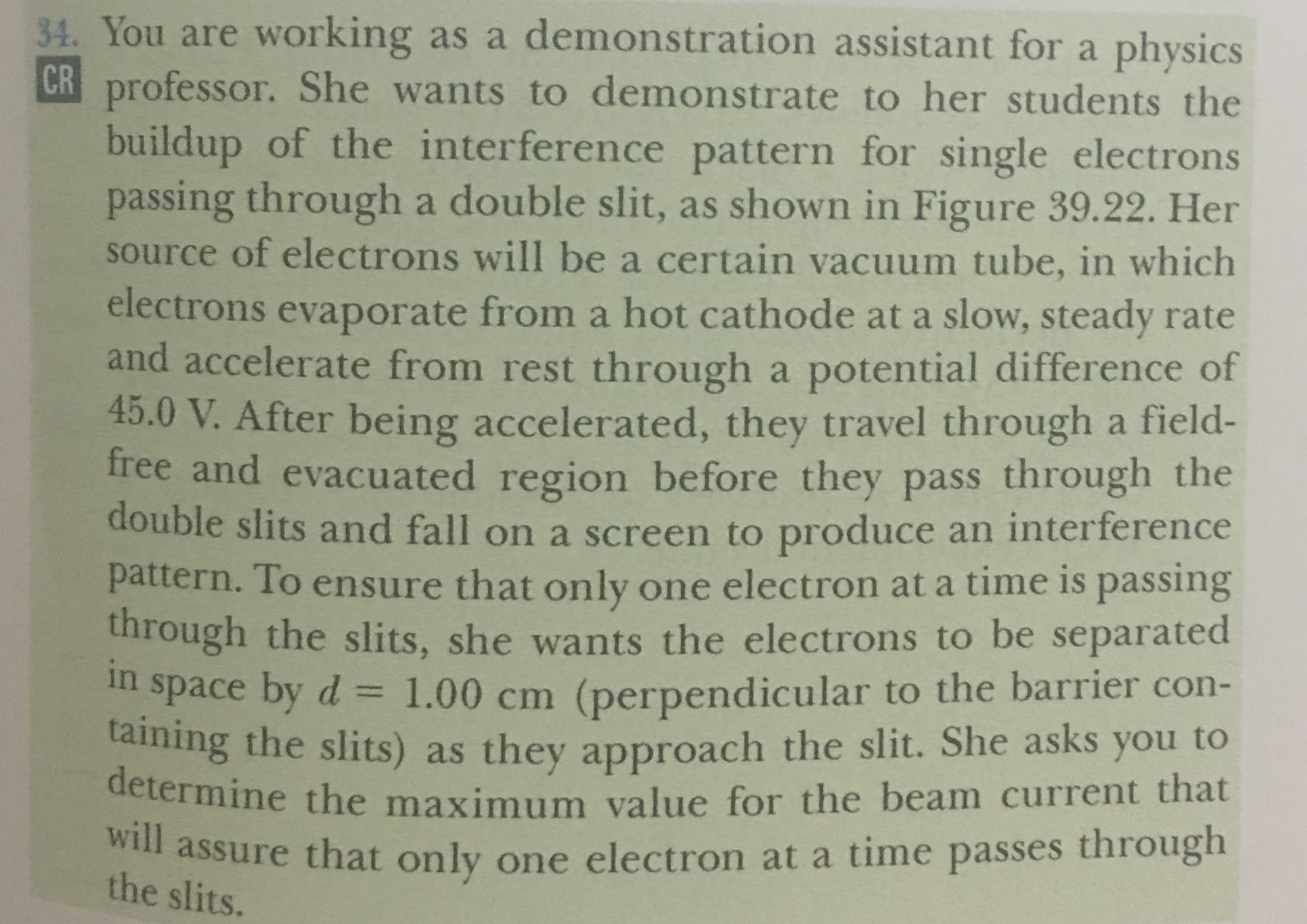34. You are working as a demonstration assistant for a physics CR professor. She wants to demonstrate to her students the buildup of the interference pattern for single electrons passing through a double slit, as shown in Figure 39.22. Her source of electrons will be a certain vacuum tube, in which electrons evaporate from a hot cathode at a slow, steady rate and accelerate from rest through a potential difference of 45.0 V. After being accelerated, they travel through a field- free and evacuated region before they pass through the double slits and fall on a Screen to produce an interference pattern. To ensure that only one electron at a time is passing through the slits, she wants the electrons to be separated in space by d = 1.00 cm (perpendicular to the barrier con- taining the slits) as they approach the slit. She asks you to determine the maximum value for the beam current that will assure that only one electron at a time passes through the slits. After just 28 electrons, no regular pattern appears. a After 1 000 electrons, a pattern of fringes begins to appear. b After 10 000 electrons, the pattern looks very much like the many-electron result shown in d. C Two-slit electron pattern (many-electron result) Figure 39.22 (a)-(c) Computer- simulated interference patterns for a small number of electrons incident on a double slit. (d) Computer simulation of a double-slit interference pattern produced by many electrons.
34. You are working as a demonstration assistant for a physics CR professor. She wants to demonstrate to her students the buildup of the interference pattern for single electrons passing through a double slit, as shown in Figure 39.22. Her source of electrons will be a certain vacuum tube, in which electrons evaporate from a hot cathode at a slow, steady rate and accelerate from rest through a potential difference of 45.0 V. After being accelerated, they travel through a field- free and evacuated region before they pass through the double slits and fall on a Screen to produce an interference pattern. To ensure that only one electron at a time is passing through the slits, she wants the electrons to be separated in space by d = 1.00 cm (perpendicular to the barrier con- taining the slits) as they approach the slit. She asks you to determine the maximum value for the beam current that will assure that only one electron at a time passes through the slits. After just 28 electrons, no regular pattern appears. a After 1 000 electrons, a pattern of fringes begins to appear. b After 10 000 electrons, the pattern looks very much like the many-electron result shown in d. C Two-slit electron pattern (many-electron result) Figure 39.22 (a)-(c) Computer- simulated interference patterns for a small number of electrons incident on a double slit. (d) Computer simulation of a double-slit interference pattern produced by many electrons.
Principles of Physics: A Calculus-Based Text
5th Edition
ISBN:9781133104261
Author:Raymond A. Serway, John W. Jewett
Publisher:Raymond A. Serway, John W. Jewett
Chapter28: Quantum Physics
Section: Chapter Questions
Problem 30P
Related questions
Question

Transcribed Image Text:34. You are working as a demonstration assistant for a physics
CR professor. She wants to demonstrate to her students the
buildup of the interference pattern for single electrons
passing through a double slit, as shown in Figure 39.22. Her
source of electrons will be a certain vacuum tube, in which
electrons evaporate from a hot cathode at a slow, steady rate
and accelerate from rest through a potential difference of
45.0 V. After being accelerated, they travel through a field-
free and evacuated region before they pass through the
double slits and fall on a Screen to produce an interference
pattern. To ensure that only one electron at a time is passing
through the slits, she wants the electrons to be separated
in space by d = 1.00 cm (perpendicular to the barrier con-
taining the slits) as they approach the slit. She asks you to
determine the maximum value for the beam current that
will assure that only one electron at a time passes through
the slits.

Transcribed Image Text:After just 28 electrons, no
regular pattern appears.
a
After 1 000 electrons, a pattern
of fringes begins to appear.
b
After 10 000 electrons, the
pattern looks very much
like the many-electron
result shown in d.
C
Two-slit electron pattern
(many-electron result)
Figure 39.22 (a)-(c) Computer-
simulated interference patterns for a
small number of electrons incident on
a double slit. (d) Computer simulation
of a double-slit interference pattern
produced by many
electrons.
Expert Solution
This question has been solved!
Explore an expertly crafted, step-by-step solution for a thorough understanding of key concepts.
This is a popular solution!
Trending now
This is a popular solution!
Step by step
Solved in 4 steps with 4 images

Recommended textbooks for you

Principles of Physics: A Calculus-Based Text
Physics
ISBN:
9781133104261
Author:
Raymond A. Serway, John W. Jewett
Publisher:
Cengage Learning

Physics for Scientists and Engineers with Modern …
Physics
ISBN:
9781337553292
Author:
Raymond A. Serway, John W. Jewett
Publisher:
Cengage Learning

Modern Physics
Physics
ISBN:
9781111794378
Author:
Raymond A. Serway, Clement J. Moses, Curt A. Moyer
Publisher:
Cengage Learning

Principles of Physics: A Calculus-Based Text
Physics
ISBN:
9781133104261
Author:
Raymond A. Serway, John W. Jewett
Publisher:
Cengage Learning

Physics for Scientists and Engineers with Modern …
Physics
ISBN:
9781337553292
Author:
Raymond A. Serway, John W. Jewett
Publisher:
Cengage Learning

Modern Physics
Physics
ISBN:
9781111794378
Author:
Raymond A. Serway, Clement J. Moses, Curt A. Moyer
Publisher:
Cengage Learning

University Physics Volume 3
Physics
ISBN:
9781938168185
Author:
William Moebs, Jeff Sanny
Publisher:
OpenStax